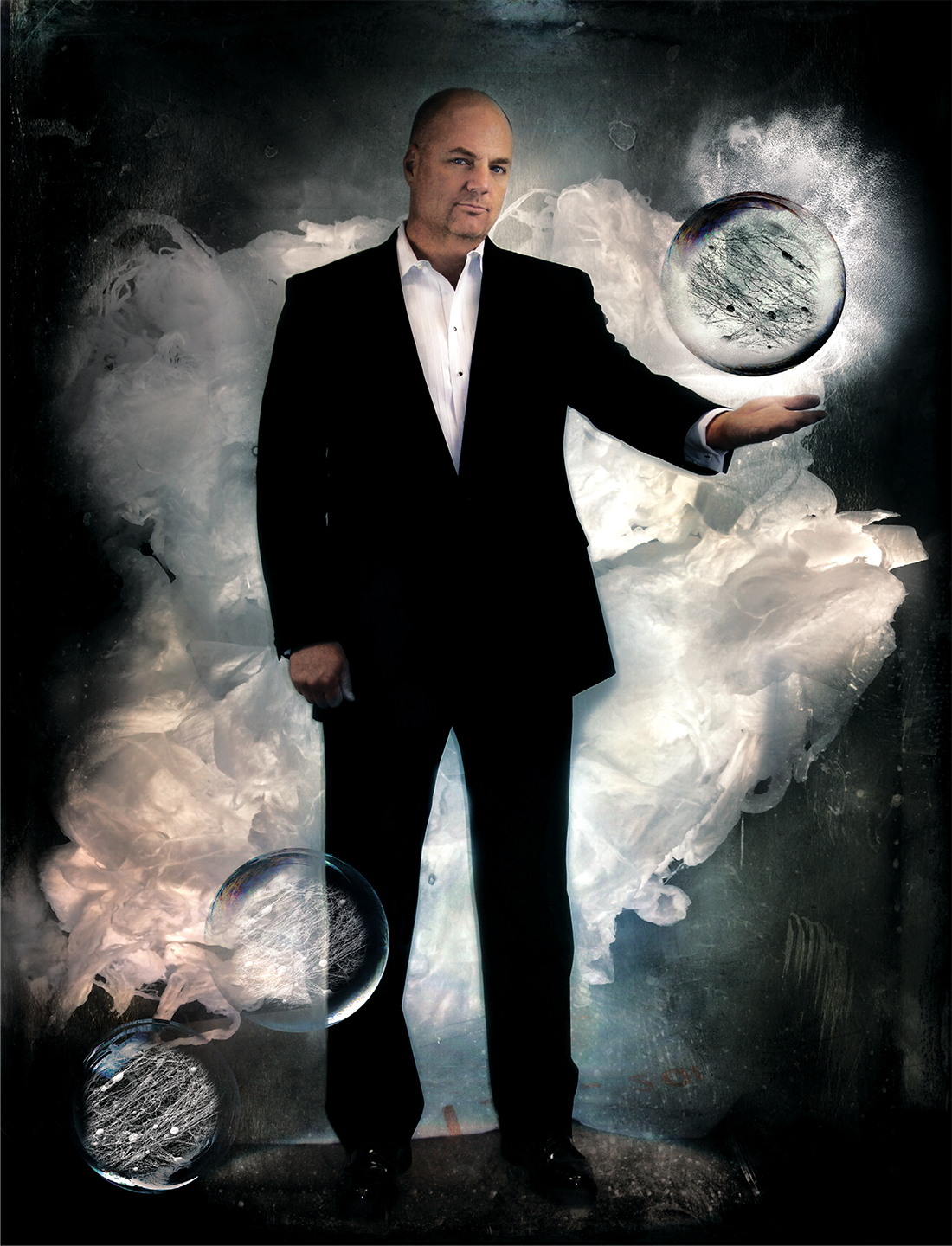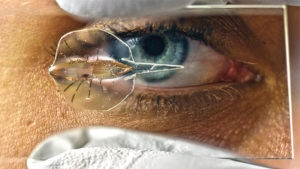BY JESSICA NEVILLE, BA’94

Expect the unexpected when you walk into Kit Parker’s biophysics lab at Harvard. From cuttlefish skin camouflage to cotton candy machines used for wound dressings, his science is anything but ordinary. In fact, the young scientists inside are just as likely to be playing with crayons to visualize solutions to complex problems as they are building new tissues for use in artificial hearts or brains.
“I have three artists in my group,” says Parker, MS’93, PhD’98, who is the Tarr Family Professor at Harvard University. “A few years ago I decided that I needed to expand my hiring from just the best scientists and engineers to the most creative people I could find. We have always had quite a bit of creative craziness in the lab.”
It’s that out-of-left-field, creative flair that has put Parker’s work in the spotlight during the past year. As part of his quest to build an artificial heart, he has created a robotic stingray as a training exercise for building muscular pumps, using material from a breast implant, rat cells, and a pinch of gold. In another area of research, Parker drew upon his combat experience as a reservist in the U.S. Army to propose a revolutionary new way of understanding traumatic brain injury.
Both projects have attracted the attention of the scientific community and media outlets like The Wall Street Journal, The New York Times and NPR.
“Of all the students I’ve taught, Kit had the most refined strategic sense,” says John Wikswo, the Gordon A. Cain University Professor, A.B. Learned Professor of Living State Physics, and professor of biomedical engineering at Vanderbilt, who was Parker’s faculty adviser for his master’s in mechanical engineering and his Ph.D. in biological and applied physics. He also is director of the Vanderbilt Institute for Integrative Biosystems Research and Education (VIIBRE) in the School of Engineering.
“He reviewed my CV, pointed out a weakness in my research and publication strategy, and proposed to correct it,” Wikswo says. “He was an extraordinarily serious, no-nonsense student who understood the big picture in science.”
While at Vanderbilt, Parker’s research involved studies of the electrical and magnetic fields generated by cardiac electromechanical activity. He also worked in the cardiology lab of Dr. David E. Hansen, associate professor of medicine, where he utilized a sophisticated system for studying arrhythmias in rabbit hearts.
Parker credits Wikswo for customizing a doctoral program to suit his research interests.
“In discussions about innovation, no one talks about how challenging it is to be a leader when you have a rogue creative type underneath you,” Parker says. “John Wikswo let me do my Ph.D. in physics thinking about mechanical electric coupling in the heart. He is a testament to a thesis adviser who creates a condition where a graduate student can go off on a rogue idea that didn’t necessarily fit the mold of a physics department.”
‘YOUR WHOLE LIFE IS YOUR IDEA LAB’
Parker’s whole scientific career, in fact, seems to be defined by taking unexpected paths, including his initial introduction to Vanderbilt Graduate School.
It was a hot day in the summer of 1989. Parker had just graduated from Boston University with a B.S. in biomedical engineering without much fanfare and had joined his father on a visit to see his grandmother in Jackson, Tennessee, where she was recovering from eye surgery.
“On the way back I asked my dad if he would stop the car at Vanderbilt so I could run in and get a brochure about the engineering master’s program,” Parker recounts. He dashed into Olin Hall and there struck up a conversation with Alvin Strauss, professor of mechanical engineering and chair of the department at the time. Ninety minutes later—as his dad waited in the broiling summer heat—Strauss invited Parker, on the spot, to start classes the very next week.
“I thought, if he knows my undergraduate grades, I’m toast. I couldn’t believe what I was hearing. So of course I said, ‘Yeah, sure, I can do that,’” says Parker, whose grandfather had attended Peabody College and great-uncle had attended Vanderbilt Divinity School. “The whole ride back, my dad simply didn’t believe me that I was going to study at Vanderbilt.”
As soon as he got home, Parker went to his church and typed up a formal application for admission, drove back to Boston to pack up, and then headed straight to Nashville to start his graduate studies.

After earning a coveted spot in Wikswo’s lab, Parker encountered a landmark paper in The New England Journal of Medicine about the failure of a famous clinical trial examining medical treatments of cardiac arrhythmia. The research findings showed that the likelihood of survival was four times greater if the patient were on a placebo versus the intervention drug, which had killed a lot of people.
“At the time I started thinking, what if you didn’t have to test a drug in a patient? What if you could try it in a surrogate of the patient?” Parker says. “Which gave me the idea, what if we just build a heart so we have the tools to test a drug without putting anyone in danger?”
Years later in his lab at Harvard, Parker constructed his robotic stingray with tissue he engineered to better understand the fundamental laws of muscular pumps. Nearly all the muscles of marine organisms exist to do just one thing: move fluid and pump. This functionality mimics the heart’s main role of pumping blood throughout the body. Parker’s stingray swims just like the real thing, with pace-making control and elastic recoil, when prompted by shining a blue light on the robo-creature.
Parker got the idea for a stingray when his young daughter tried to touch a real one in a glass tank at the New England Aquarium in Boston.
“It just kind of hit me like a thunderbolt,” remembers Parker. “I can build a stingray to function like the endocardial surface of the heart chamber. Creative ideas come like a thief in the night. You have to spend a lot of time in the lab. But your whole life is your idea lab.”
GOOD SCIENCE IS MOTIVATED BY LOVE
After Vanderbilt, Parker secured postdoctoral fellowships in pathology at Boston Children’s Hospital and in biomedical engineering at the Johns Hopkins School of Medicine. Having joined ROTC as a graduate student, Parker also was commissioned as an infantry officer in the U.S. Army Reserve and served two combat tours in Afghanistan, receiving multiple honors for his service.
Parker earned the prestigious rank of lieutenant colonel and was selected by the Joint Chiefs of Staff to serve on their science advisory team, the Gray Team. As the team’s officer, Parker completed two additional missions to Afghanistan to evaluate issues around combat casualties and care.
During his tour in 2002, Parker encountered his first improvised explosive device (IED) blast. A few years later a close friend returned home from Iraq, wounded and suffering from traumatic brain injury (TBI). These war wounds inspired a twist in Parker’s research focus.
“I decided that I’d better turn to neuroscience if my friends and I want to survive this war,” he says. “So I started thinking about mechanical blows to the brain.”

Parker had done his Ph.D. thesis on commotio cordis—a scientific term for a sudden blow to the chest that causes cardiac death. By the time he finished his Ph.D., Parker was convinced that integrin signaling was the cause. Integrins are proteins whose function is to link a cell’s exterior to the biochemical and structural supports inside. They also play a critical role in communication, activating signaling pathways within a cell.
After doing extensive literature searches on the brain, Parker thought that integrins also could play an important role in traumatic brain injuries—that the same negative signaling that caused heart damage after a hit to the chest also could be the cause for damage in the brain after a blast wave.
Without any grant money available to test his idea, Parker phoned one of his undergraduate students to meet him early one morning at a local Starbucks. Together they sketched out his hypothesis on a napkin. Next, Parker built a piece of brain in his lab so he could simulate an IED blast. His initial assumptions turned out to be exactly right.
However, the path to publication wasn’t an easy one.
“We had a very difficult time with the journal editors because our hypothesis was so far out of left field with what everyone else had been thinking about brain injury,” Parker says. “The neuroscientists weren’t even familiar with the concept of mechanical transduction in our research.”
Now Parker is spending a lot of time trying to better understand integrin signaling. “We do a lot in my laboratory,” he says, “but the brain injury project is the one thing that’s got to survive.”
According to the Centers for Disease Control, TBI is a major cause of death and disability in the U.S., contributing to about 30 percent of all injury deaths. In 2009 nearly 250,000 children under the age of 19 were treated for sports and recreation-related injuries that included a diagnosis of concussion or TBI.
While Parker is trying to recruit pharmaceutical companies to take up the fight, it’s an uphill battle.
“I see this work as an imperative of my leadership in the military and my social responsibility at Harvard, so that’s what I’m trying to do—to trim the edges off this problem,” Parker says. “The primary motivation of good science should be the problems that affect your loved ones. You’ll always be motivated.”
Jessica Neville, BA’94, is a strategic communications and public relations consultant. A longtime New Yorker and PR agency veteran, she now lives in Toronto.